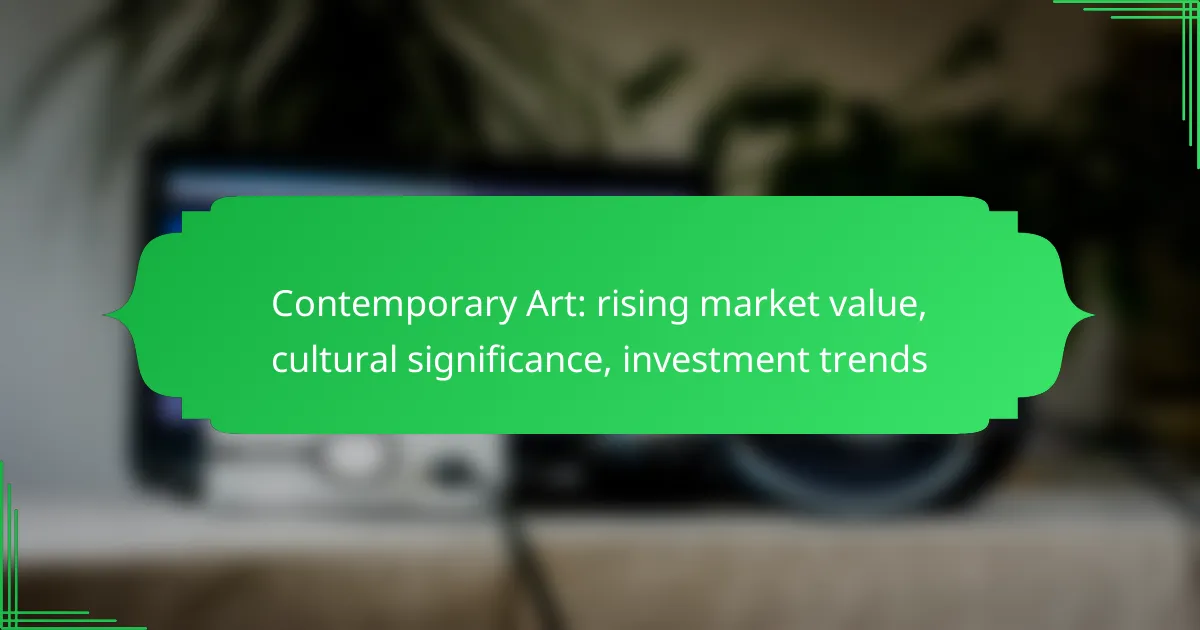The contemporary art market is experiencing a notable surge in value, driven by rising auction prices and increased interest from institutional investors. This dynamic landscape not only reflects the evolving tastes of collectors but also underscores the cultural significance of contemporary art as a medium for expressing societal values and challenges. As online platforms expand access, both seasoned and new investors are drawn to the multifaceted potential of contemporary artworks.

What are the current investment trends in contemporary art in the UK?
Investment trends in contemporary art in the UK are characterized by rising auction prices, increased participation from institutional investors, and the growth of online art platforms. These factors indicate a robust market that is attracting both seasoned collectors and new investors.
Increased auction prices
In recent years, auction prices for contemporary art in the UK have seen significant increases, often reaching millions of pounds for top works. This trend reflects not only the growing demand but also the limited supply of high-quality pieces. Collectors should be prepared for competitive bidding environments, especially for works by renowned artists.
Notable auction houses like Sotheby’s and Christie’s have reported record sales, with some pieces fetching prices that exceed previous estimates by substantial margins. Investors should consider the historical performance of artists when evaluating potential purchases, as certain names consistently appreciate in value.
Growing interest from institutional investors
Institutional investors, including hedge funds and private equity firms, are increasingly entering the contemporary art market, viewing it as a viable asset class. This shift is driven by the desire for portfolio diversification and the potential for high returns. Institutions often invest in blue-chip artworks, which tend to hold their value better over time.
As institutional interest grows, it can lead to increased liquidity in the market, making it easier for individual investors to buy and sell artworks. However, potential investors should be aware of the implications of this trend, such as rising prices and competition for sought-after pieces.
Emergence of online art platforms
The rise of online art platforms has transformed how contemporary art is bought and sold in the UK. Websites like Artsy and Saatchi Art provide accessible marketplaces for both emerging and established artists, allowing investors to discover new talent without the traditional gallery setting. This accessibility can lead to more informed purchasing decisions.
Online auctions and virtual exhibitions have also gained popularity, enabling collectors to participate from anywhere in the world. However, investors should exercise caution and conduct thorough research to verify the authenticity and provenance of artworks purchased through these platforms, as the digital space can sometimes lack the rigorous standards of physical galleries.
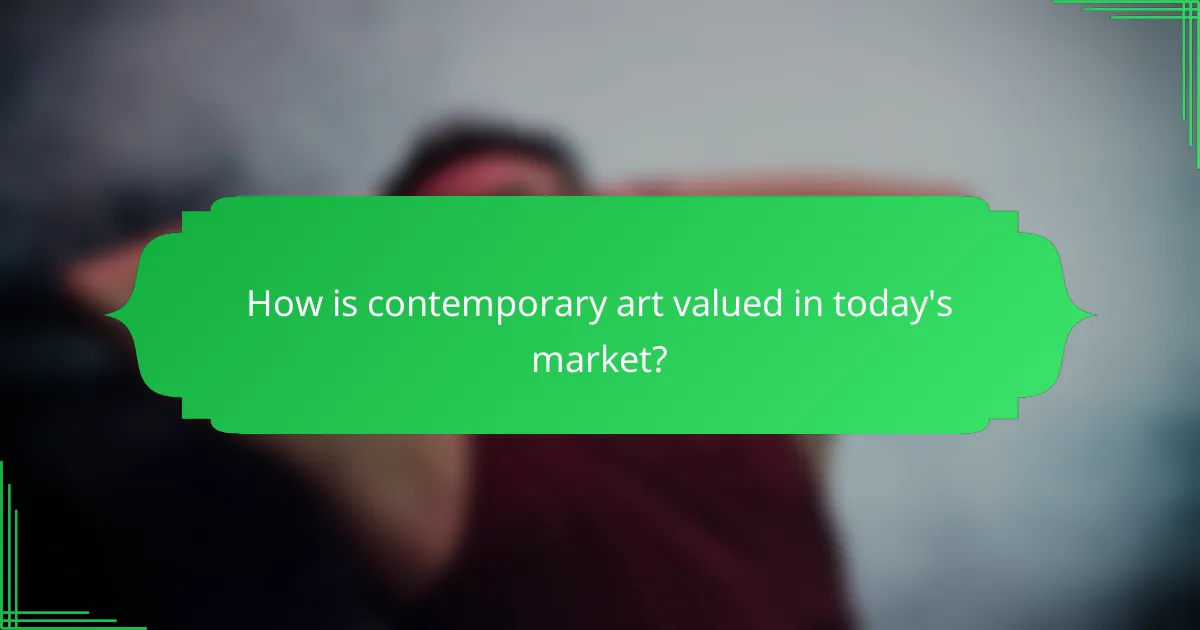
How is contemporary art valued in today’s market?
Contemporary art is valued based on a combination of factors including market demand, artist reputation, and gallery representation. These elements collectively influence pricing and investment potential, making the art market dynamic and multifaceted.
Market analysis by Artprice
Artprice provides comprehensive data on the contemporary art market, analyzing sales trends and auction results. Their reports often highlight the increasing value of contemporary works, which have seen significant appreciation over the past decade. For instance, the market has shifted towards younger artists, with many fetching high prices at auctions.
Investors should consider Artprice’s annual reports for insights into which artists are gaining traction and which styles are currently in demand. This data can guide purchasing decisions and help identify potential investment opportunities.
Influence of artist reputation
The reputation of an artist plays a crucial role in determining the value of their work. Established artists with a strong track record can command significantly higher prices compared to emerging talents. Collectors often seek works from artists who have been recognized in prestigious exhibitions or have received notable awards.
When investing in contemporary art, it’s essential to research an artist’s background, including their exhibition history and critical acclaim. This can provide insight into their future market potential and help avoid overpaying for lesser-known artists.
Impact of gallery representation
Gallery representation can greatly influence an artist’s market value. Artists represented by reputable galleries often benefit from better visibility and marketing, which can lead to higher sales prices. Galleries curate their artist roster carefully, and being associated with a well-regarded gallery can enhance an artist’s credibility.
For collectors, purchasing works from artists represented by established galleries can be a safer investment. It’s advisable to consider the gallery’s history, its previous sales, and how it supports its artists in building their careers.
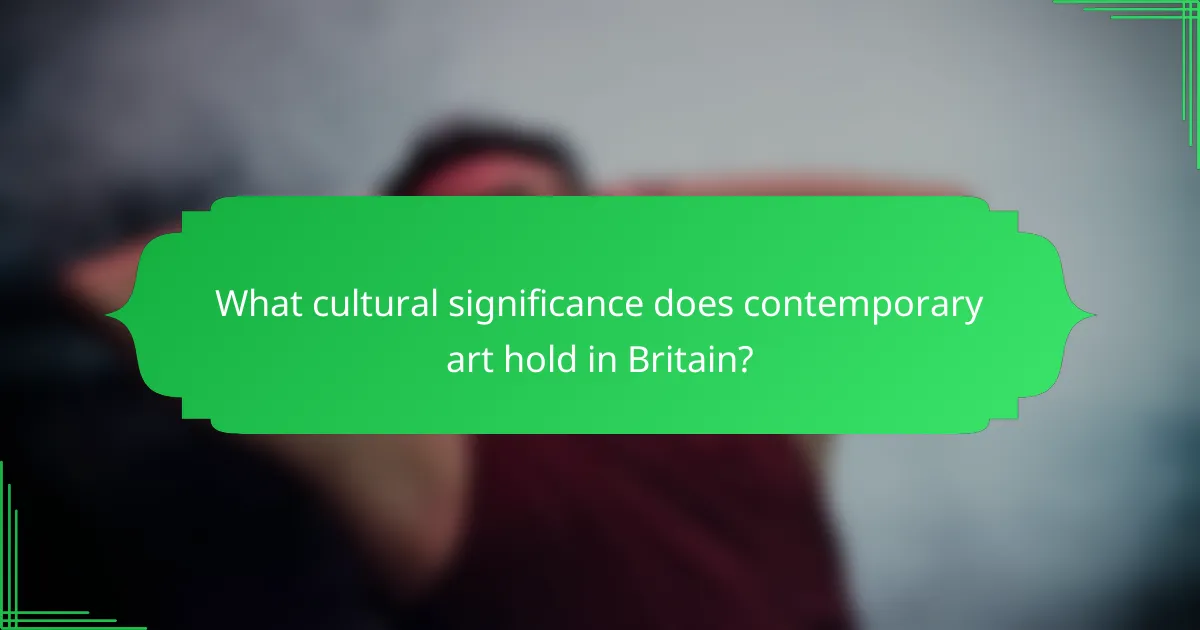
What cultural significance does contemporary art hold in Britain?
Contemporary art in Britain serves as a vital reflection of current societal values, challenges, and aspirations. It plays a crucial role in shaping cultural identity and fostering dialogue around pressing issues, making it significant both artistically and socially.
Reflection of societal issues
Contemporary art often addresses pressing societal issues such as inequality, climate change, and political unrest. Artists use their work to comment on these topics, provoking thought and discussion among viewers. For instance, installations or performances that highlight the impact of urban poverty can create awareness and inspire action.
Moreover, exhibitions frequently feature works that respond to current events, making art a powerful medium for social commentary. This engagement with real-world issues helps to bridge the gap between art and everyday life, encouraging public discourse.
Promotion of diversity and inclusion
Contemporary art in Britain actively promotes diversity and inclusion by showcasing a wide range of voices and perspectives. Galleries and institutions increasingly prioritize underrepresented artists, including those from various ethnic backgrounds, genders, and abilities. This shift not only enriches the art scene but also reflects the multicultural fabric of British society.
Initiatives such as community art projects and inclusive exhibitions aim to engage diverse audiences, fostering a sense of belonging and representation. By doing so, contemporary art becomes a platform for dialogue and understanding among different cultural groups.
Role in urban regeneration
Contemporary art plays a significant role in urban regeneration efforts across Britain. By transforming neglected spaces into vibrant cultural hubs, art can breathe new life into communities. Public art installations and murals, for example, can enhance the aesthetic appeal of an area while attracting visitors and investment.
Additionally, art festivals and events often stimulate local economies by drawing crowds and encouraging spending in nearby businesses. This symbiotic relationship between art and urban development highlights the potential for contemporary art to contribute to the revitalization of urban areas, making them more livable and attractive.
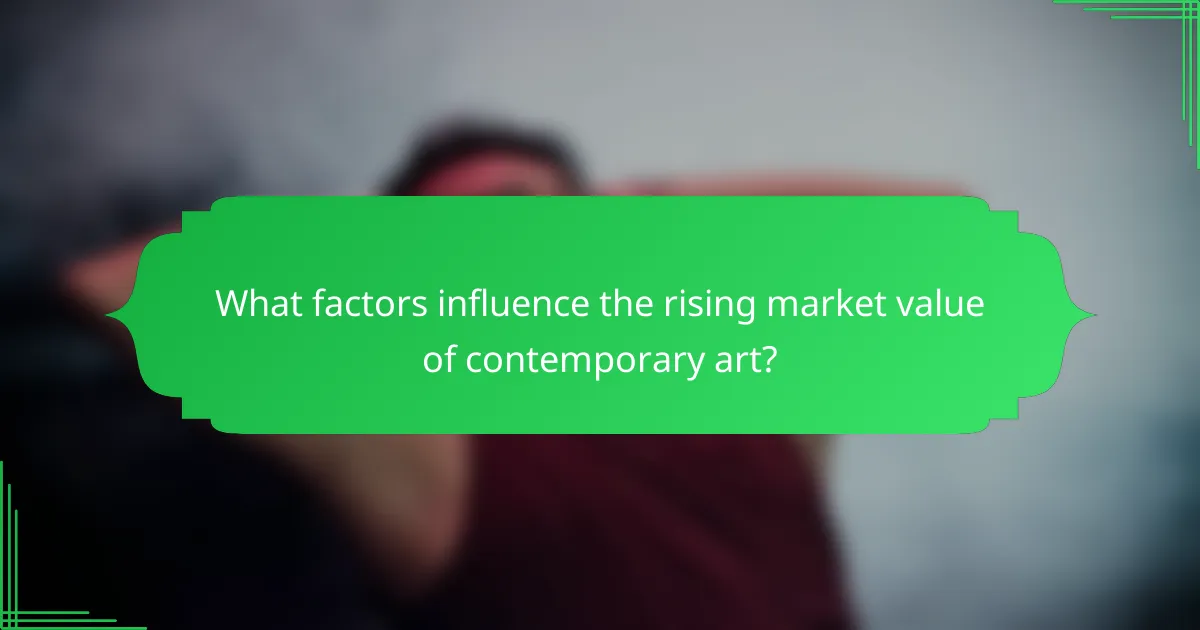
What factors influence the rising market value of contemporary art?
The rising market value of contemporary art is influenced by a combination of economic conditions, celebrity endorsements, and advancements in technology that facilitate art sales. These factors create a dynamic environment where demand and prices can fluctuate significantly.
Global economic conditions
Global economic conditions play a crucial role in the art market, as they affect disposable income and investment behaviors. During periods of economic growth, collectors are more likely to invest in contemporary art, driving up prices. Conversely, economic downturns can lead to decreased spending and lower valuations.
Art markets often reflect broader economic trends, such as inflation or changes in interest rates. For instance, when inflation rises, investors may turn to art as a hedge against currency devaluation, further increasing its market value.
Celebrity endorsements
Celebrity endorsements significantly impact the perceived value of contemporary art. When high-profile individuals purchase or promote specific artworks, it can create a surge in interest and demand, leading to increased prices. This phenomenon is often seen at auctions where celebrity-owned pieces fetch much higher bids.
Moreover, celebrities using social media to showcase their art collections can influence their followers and the general public, making contemporary art more desirable. This trend highlights the importance of cultural relevance and visibility in the art market.
Technological advancements in art sales
Technological advancements have transformed how contemporary art is bought and sold, contributing to its rising market value. Online platforms and virtual galleries allow collectors to access a broader range of artworks without geographical limitations, increasing competition and demand.
Additionally, innovations such as blockchain technology and NFTs (non-fungible tokens) have introduced new ways to authenticate and trade art, appealing to a younger, tech-savvy audience. These developments not only enhance transparency but also create new investment opportunities in the art market.
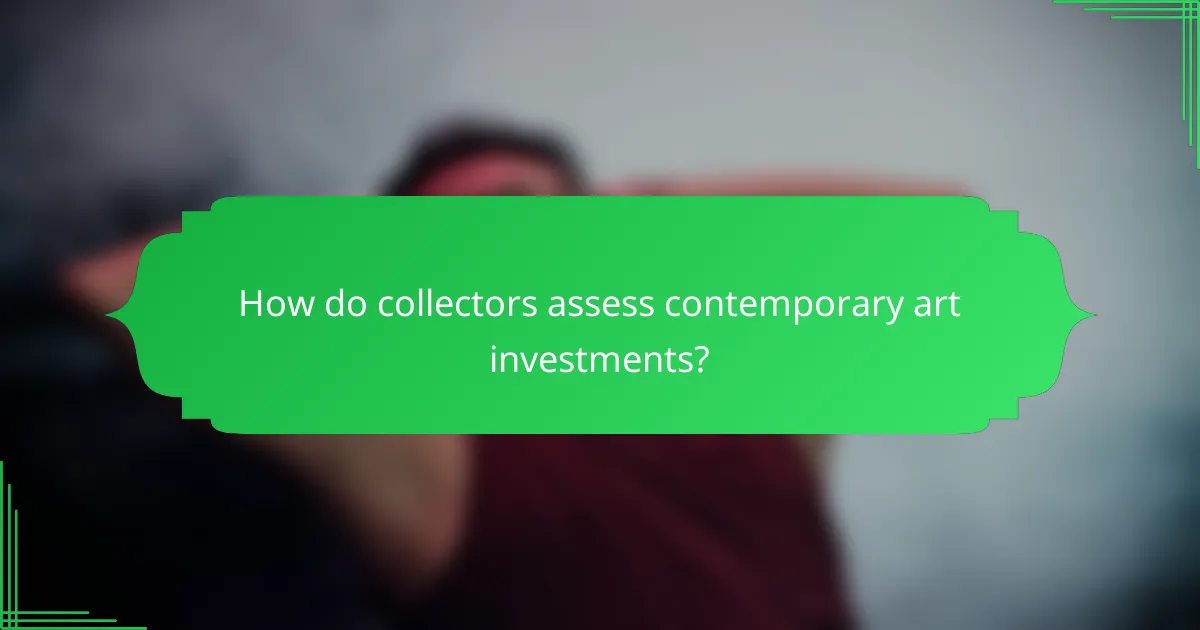
How do collectors assess contemporary art investments?
Collectors assess contemporary art investments by evaluating various factors that influence both market value and cultural significance. Key considerations include market reports, provenance, authenticity, and expert consultations.
Art market reports
Art market reports provide valuable insights into current trends, pricing, and demand for contemporary art. These reports often analyze auction results, gallery sales, and market forecasts to help collectors understand which artists and styles are gaining traction.
Collectors should pay attention to reputable sources, such as the Art Basel and UBS Global Art Market Report, which offer comprehensive data on market performance. Regularly reviewing these reports can help collectors make informed decisions and identify potential investment opportunities.
Provenance and authenticity checks
Provenance refers to the history of ownership of a piece of art, which can significantly affect its value. Collectors should verify the provenance of contemporary artworks to ensure they are purchasing legitimate pieces with a clear history.
Authenticity checks are equally crucial. Collectors can request certificates of authenticity from artists or galleries, and they may also consult experts who can verify the work’s legitimacy. Ensuring both provenance and authenticity helps mitigate the risk of acquiring counterfeit or misrepresented art.
Consultation with art advisors
Consulting with art advisors can provide collectors with expert guidance on contemporary art investments. Advisors often have extensive knowledge of the market and can help identify promising artists and artworks that align with a collector’s goals.
When choosing an art advisor, collectors should consider their experience, reputation, and track record in the contemporary art market. A good advisor can help navigate complex decisions and avoid common pitfalls, such as overpaying for a piece or investing in a declining artist.
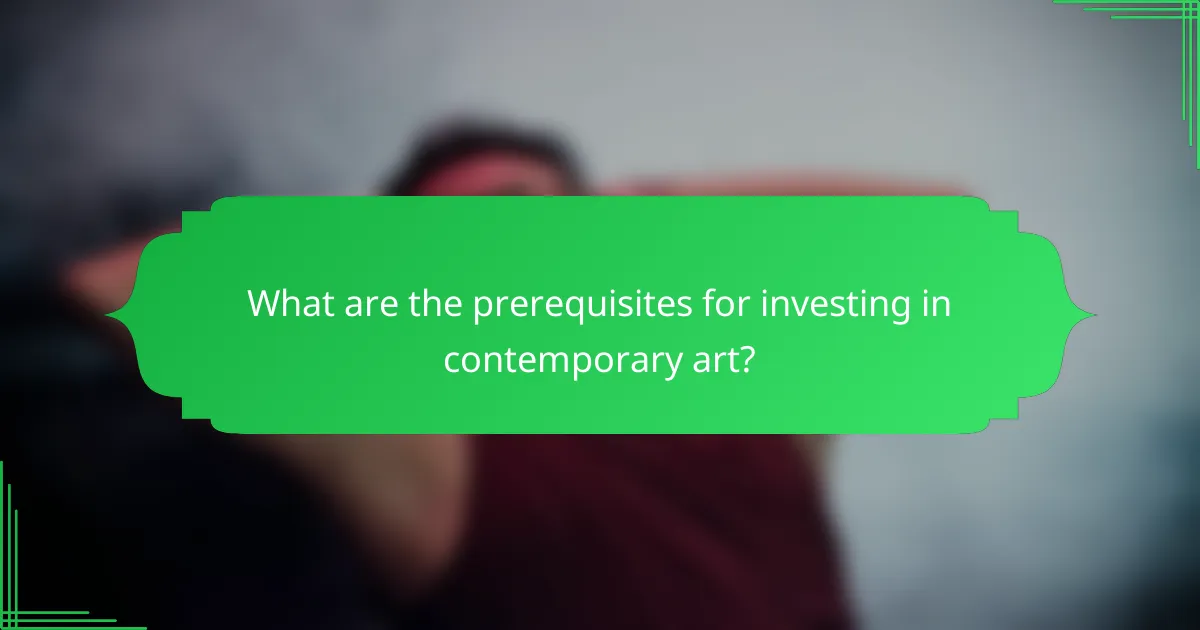
What are the prerequisites for investing in contemporary art?
Investing in contemporary art requires a solid understanding of the market, a clear budget, and a keen eye for quality. Potential investors should familiarize themselves with artists, trends, and the overall dynamics of art valuation to make informed decisions.
Understanding art market dynamics
The art market is influenced by various factors including artist reputation, market demand, and economic conditions. Prices can fluctuate significantly based on trends, making it essential to stay updated on current movements and emerging artists.
Investors should consider attending art fairs, exhibitions, and auctions to gain insights into market behavior. Engaging with galleries and art advisors can also provide valuable information on pricing and investment potential.
Building a diverse collection
A diverse art collection can mitigate risks and enhance potential returns. Investors should aim to include works from various artists, styles, and mediums, as this can protect against market volatility.
When building a collection, consider setting a budget that allows for both established and emerging artists. A balanced approach, combining high-value pieces with affordable works, can create a well-rounded portfolio that appreciates over time.

What emerging trends are shaping the future of contemporary art?
Emerging trends in contemporary art are significantly influenced by technological advancements, shifting cultural values, and evolving market dynamics. These factors are driving new forms of artistic expression and changing how art is created, consumed, and valued.
Technological Innovations
Technological innovations, such as digital art and blockchain, are reshaping the contemporary art landscape. Digital platforms allow artists to reach global audiences, while blockchain technology offers secure ways to authenticate and trade art, enhancing transparency in ownership.
For instance, NFTs (non-fungible tokens) have gained popularity, enabling artists to sell digital works with proof of ownership. This trend has opened new revenue streams for artists, but it also raises questions about the sustainability and environmental impact of digital art production.
Cultural Shifts
Cultural shifts, including increased awareness of social issues and diversity, are influencing contemporary art themes. Artists are using their work to address topics such as climate change, identity, and social justice, resonating with audiences who value authenticity and activism.
Art fairs and exhibitions are increasingly showcasing underrepresented voices, reflecting a broader commitment to inclusivity. Collectors are now more inclined to invest in works that align with their values, which can drive up the market value of socially conscious art.
Investment Trends
Investment trends in contemporary art are evolving, with collectors looking for both aesthetic value and potential financial returns. The market has seen a rise in interest from younger investors, who are more open to exploring emerging artists and unconventional mediums.
Art funds and online platforms are making it easier for investors to enter the market, allowing fractional ownership of high-value pieces. However, potential investors should be cautious and conduct thorough research, as the art market can be volatile and subjective.
